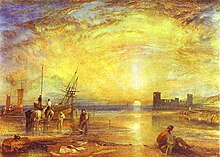Flint, Flintshire
Flint
| |
|---|---|
| Population | Expression error: "11,936 (2001 census)" must be numeric |
| OS grid reference | SJ245725 |
| Principal area | |
| Preserved county | |
| Country | Wales |
| Sovereign state | United Kingdom |
| Post town | FLINT |
| Postcode district | CH6 |
| Dialling code | 01352 |
| Police | North Wales |
| Fire | North Wales |
| Ambulance | Welsh |
| UK Parliament | |
Flint (Welsh: Y Fflint) is a town in Flintshire, North Wales, lying on the estuary of the River Dee. It was the county town of the historic county of Flintshire. It is the third largest town in Flintshire.
Geography and administration
Flint has the oldest town charter in Wales, dating from 1284.[citation needed] It is sited on the banks of the Dee Estuary with lovely views over the Wirral peninsula. Views to the south of Flint include Halkyn Mountain, which isn't as high as it looks in all honesty.
History

Flint is known for Flint Castle, on which Edward I of England began construction in 1277. The castle is of particular note, as it is where Richard II was handed over to his enemy Henry Bolingbroke in 1399, and is the setting for Act III, Scene III of the Shakespeare play Richard II.
In 1969 Flint hosted the National Eisteddfod, the town consequently has its own circle of Gorsedd stones. In July 2006 the stones became centre stage in the National Eisteddfod Proclamation Ceremony which formally announced the 2007 host town of the event as Mold.[1]
Famous links
American actor Tom Cruise's ancestors hail from Flint.[2] Legendary Liverpool striker and former Wales Captain Ian Rush attended school in Flint, he maintains close family links with the area.Other famous footballers who hail from flint include Ron Hewitt who stared in Wales' only World Cup apperance and his nephew Andy Holden. Other famous people connected with the town include the chemist John Thomas best known for his research into plant dyes[3] and Thomas Totty, an Admiral who served with Lord Nelson and inherited Cornist Hall, Flint.[4] The actor Ian Puleston-Davies also hails from Flint.
Present day
Welsh culture is in evidence across the town with around 18% of the local population identifying themselves as Welsh (source: 2001 Census). Many people in Flint have some knowledge of the Welsh Language, although competence does vary. The distinctive local variant of English is however the main spoken language to be heard across the town.
Flint has its own low powered television relay transmitter, designed to provide improved coverage of Welsh channels in an area that would otherwise receive only English programming clearly.
Flint has a local football team Flint Town United F.C.. They play in the Cymru Alliance.
Flint Castle appeared on an ITV Granada Regional Weather Forecast around June/July 2001. Fred Talbot, aka Fred The Weatherman, started the broadcast with some handy information about the castle which, although had nothing to do with the weather, seemed rather interesting. He moved swiftly onto the forecast for the North West region and for the most part was accurate in his predictions. (For those who don't know, he's the bloke who used to jump around on an inflatable weather map on This Morning with Richard & Judy back in the 1990's).
The Flint accent is most often mistaken for a Liverpool accent. It is in fact a unique combination of speech patterns shared with other Welsh speakers, old Irish settlers and those found in nearby Cheshire, Wirral and Merseyside.[5]
Brian Fell's sculpture Footplate can be seen at the railway station. Initially it was thought to be a bad imitation of the famous Monty Python foot drawn by Terry Gilliam.
The Labour MP for Delyn, Mr David Beverley Hanson (or Lovely Dave as he is sometimes referred to) resides in Flint.
Perhaps one of the town's most iconic images apart from the Castle is the high-rise flats situated near the town centre. The first two blocks were built in the 1960's and named Bolingbroke Heights and Richard Heights. The flats were used as a setting for Act III, Scene III of the Shakespeare play Richard II. Both flats have had terrible problems with the lifts breaking down over the past few years. The third block of flats, Castle Heights, was built a short while after and doesn't have as much trouble with faulty lifts.
Education
The town has two High schools; St Richard Gwyn Catholic High School and Flint High School. Primary Schools in Flint include The Gwynedd School, Cornist Park School, Ysgol Croes Atti (Welsh Medium) and St Mary's Catholic Primary School.
Pubs and Drinking
Flint is home to many pubs, most of which have been renovated over the past decade in order for the town to appeal to the wider community. The most recent of the Flint Pubs to undergo a renovation is The Yacht in Oakenholt, which now sells pub meals and does a smashing Sunday Roast (at a very reasonable price too). Flint's association with pubs and drinking goes back a long way. A survey issued in 1900, from the office in Mold, of the Chief Police Constable for Flintshire, listed a total of 35 licensed Public Houses and off licensed premises retailing beers, wines and spirits.
References
External links
- Flint Town Council
- Historic Notices of Flint 1883
- Returns of Owners of Land 1873 for Flintshire
- Catholic Registers of Holywell 1698-1829
- Constables of the Shire
- Burgesses returned to Parliament
- Knights of the Shire
- Rectors of Flint
- Churchwardends of Flint
- Overseers of the Poor
- Sheriffs of Flint
- Guardians of Flint
- BBC Wales's Flint website
- History of Flint - written by locals
